


The WISE Level 1 astrometric requirements state:
"The root mean square error in WISE catalog positions with respect to 2MASS catalog positions shall be less than 0.5 arcsec, for sources with SNR > 20 in at least one WISE band, where the noise includes flux errors due to zodiacal foreground emission, instrumental effects, source photon statistics, and neighboring sources. This requirement shall not apply to sources that are superimposed on an identified artifact."
A Level 4 requirement clarifies that the 0.5 arcsec accuracy applies to each axis (that is, R.A. or Declination independently).
WISE astrometric solutions are tied to the 2MASS reference frames via WISE point source extractions in common with a bright, astrometrically clean subset of the 2MASS catalog (detailed in IV.4.d; see also the 2MASS astrometric reference sample, 2MRef). Since the flux limit for 2MASS was brighter than that of WISE, every WISE Tile typically contains hundreds of these 2MASS positional references. As a result, the reference frame for WISE astrometry is rigid and precise around the sky relative to 2MASS. 2MASS positions for bright sources were accurate to <0.1 arcsecond relative to the International Celestial Reference System (ICRS) reference frame at the 2MASS epoch of observation. (see the 2MASS Explanatory Supplement, section VI.6.a). Since the WISE Source Catalog includes positional associations with 2MASS as well as positional differences between WISE and 2MASS via the Catalog columns r_2mass and pa_2mass, the quality of WISE astrometry can be validated directly from these Catalog columns. These WISE-2MASS differences are a meaningful measure of WISE astrometry since only three free parameters (two translation + rotation) are fit for each single-exposure frameset (band-to-band offsets, plate scales and distortion are priors determined from off-line analysis) based on several hundred reference star matches per frame.
Figure 1 shows a representative histogram of 2MASS vs. WISE RA and Dec differences for bright (W1<12.5 mag) WISE sources. The WISE positions for these bright WISE sources is not adopted directly from the 2MASS position but derived from a full solution to the WISE frame. The FWHM of these histograms is typically <0.2" in both R.A. and Declination demonstrating that the astrometric residuals for bright WISE sources surpass the the Level 1 requirement of RMS<0.5" on each axis. Such results obtain consistently all over the sky.
The WISE Level 1 requirement states that positional uncertainties relative to 2MASS shall be less that 0.5" for sources with SNR>20 in any one band. W1 tends to dominate the other bands in SNR and SNR=20 is characteristic of W1~16 mag. Figure 2 shows a histogram of 2MASS vs. WISE RA and Dec differences for sources with 15.5>W1>16.0 mag. The RMS for these fainter sources (~0.4") is larger due to the lower SNR detections of these objects but still better than the WISE Level 1 requirement.
The WISE Preliminary Release astrometry suffered from the effects of a pipeline coding error which significantly biased the position of about 20% of the faint (W1>13 mag) sources in the catalog by as much as 1 arcsecond. This error was subsequently identified and corrected in second-pass processing. The All-Sky Release products do not suffer from this astrometric bias.
On a global scale, the astrometric quality of the ensemble of WISE Tiles can illuminate the quality of the WISE dataset relative to the 2MASS astrometric reference system. Figures 3 and 4 show all-sky maps in galactic coordinates of the mean offset, Tile by Tile, divided into declination and right ascension components. Each point in these maps results from an evaluation of the mean between the WISE and 2MASS positions for all WISE sources with SNR>20 and w1rchi2<2 for a given Tile. Overall these residuals are quite small, amounting to tens of milliarcseconds. The residuals show coherent trends over the sky. These trends result from the difference in net proper motion between the 2MASS and WISE epochs for the bright subset of 2MASS stars used to derive the WISE astrometric frame solutions (i.e. the 2MASS astrometric reference sample, 2MRef) and the fainter W1 SNR>20 sample used for the comparison in these plots. The implication of these differences for the overall WISE astrometric reference frame is discussed below in section VI.4.f.
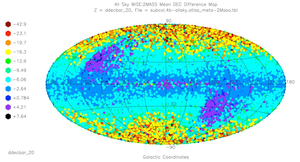 |
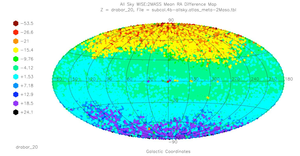 |
| Figure 3 - Mean declination difference, Tile-by-Tile, between WISE positions and 2MASS positions for all sources on a given Tile with W1 SNR>20 and w1rchi2<2. The projection is in galactic coordinates and the color coding shows position offset in milliarcseconds. | Figure 4 - As in Figure 3, but for the right ascension component of the offset. |
Although there are large numbers of 2MASS associations for each coadd image, the majority of WISE sources have no 2MASS counterparts (Figure 5). Simple coadd overlays of reported source position can provide a first order check that the pipeline is properly transferring the astrometric solution derived from the brighter sources to the fainter ones. In addition, detection of fainter WISE sources in other astrometrically accurate surveys (e.g. SDSS) can provide a test of the astrometric quality of WISE extractions at the faintest flux levels. Figure 6 shows that the distribution of WISE vs. SDSS position differences for all sources in a small (15' diameter) test region containing the image in Figure 5 are not significantly biased.
The astrometric position for each WISE source is a weighted combination of information from all four WISE bands. The predominant tie between 2MASS and WISE, however, exists via sources detected in W1 and to a lesser extent in W2, since the sources in common are primarily stars. Sources detected by WISE in W3 and W4 only must inherit an astrometric solution from bluer sources. The WISE Science Team conducted follow-up studies of sources that are undetected in the W1 and W2 bands. These W3/W4 only sources tend to have fluxes close to the SNR=20 limit where WISE astrometry is expected to be better than 0.5" RMS on each axis (Figure 7). Figure 8 shows WISE vs. Spitzer IRAC position difference (declination component) for ~900 of these W1/2 dropout sources. The RMS of this distribution is 0.35" in declination. Evaluation of the right ascension component produces a symmetrical result.
WISE Atlas Images include WCS FITS header information that establishes the image astrometric reference frame. The positions of sources derived directly from an Atlas Image may suffer from a small astrometric offset relative to an independent assessment of positions of sources on the Atlas Images (Figure 9). The cause of this small offset remains unknown. Positions derived from the intensity-weighted centers of sources measured on the Atlas (and Single-exposure) Images transformed to equatorial coordinates using the image World Coordinate System are biased by ~0.05" in W1, W2, ~0.2" in W3 and 0.5" in W4 relative to the Catalog reference frame. Instructions for correcting image-derived source positions and image WCS are given in II.3.g.
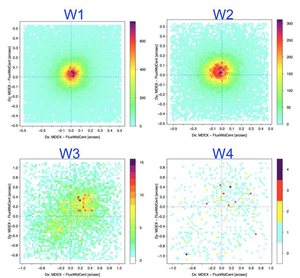 |
| Figure 9 - The distribution of differences between Atlas Image WCS positions and WISE Catalog positions for each of the four bands. |
The excellent positional precision of individual WISE source extractions permits the computation of ensemble statistics that are capable of illuminating global astrometric trends on scales of milliarcseconds. Section VI.4.b already illustrated positional offests around the sky for WISE Tiles with amplitudes as large as tens of milliarcseconds (reproduced for declination in Figure 10). Figure 11 suggests strongly that these trends have their origin in the uncompensated proper motion between the WISE (~2010) and 2MASS (~2000) epochs of observation. Figure 11 shows the mean proper motion of bright (Ks<12.5 mag) 2MASS sources, where measured in a pre-release version of the UCAC4 catalog (courtesy of N. Zacharias), that served as the primary WISE astrometric reference. The WISE astrometric solutions did not account for these proper motions (which were not available at the time of the design and implementation of the WISE pipeline), but instead used the position as reported in the 2MASS catalog. The pattern in Figure 11 mimics, spatially, the trends seen in the WISE Tile offsets in Figure 10, but the amplitude of the global features in Figure 11 is about an order of magnitude larger than the trend seen in Figure 10. This spatial trend is the signature of the Sun's motion relative to the Local Standard of Rest, also known as the Solar Apex motion.
WISE, by requirement, was tied to the 2MASS reference frame as defined by the Ks<12.5 mag 2MASS astrometric reference sample, 2MRef, but in certain directions in the sky this reference frame has shifted by as much as 0.2" between the 2MASS and WISE epochs (as demonstrated in Figure 11). The order-of-magnitude smaller Tile offset pattern seen in Figure 10 is the differential signature of these shifts between the 2MASS Ks<12.5 mag sample used to establish the WISE astrometric reference frame and the 2MASS SNR>20 sample used to calculate the mean Tile positions.
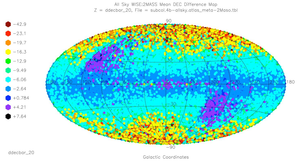 |
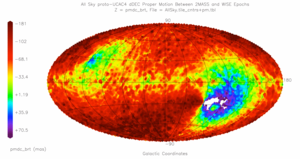 |
| Figure 10 -Mean declination difference, tile-by-tile, between WISE positions and 2MASS positions for all sources on a given Tile with W1 SNR>20 and w1rchi2<2. The projection is in galactic coordinates and the color coding shows position offset in milliarcseconds. | Figure 11 - All-sky map of mean proper motion (declination component) of UCAC4 stars corresponding to 2MASS stars with Ks<13.5 mag between epoch 2000.0 and epoch 2010.0. Color coding is in milliarcseconds. |
Figures 12 and 13 provide a direct assessment of the mean difference in position between WISE and UCAC4 evaluated at epoch 2010.0 (which is representative of the ICRS). Due to the motion of the Sun toward the Solar Apex combined with 10 years of uncorrected proper motion between the WISE and 2MASS epochs the WISE coordinate frame is distorted relative to the International Celestial Reference frame with a pattern reflecting the Solar Apex motion and having a peak amplitude of ~0.1-0.2 arcseconds for the most extreme locations on the sky.
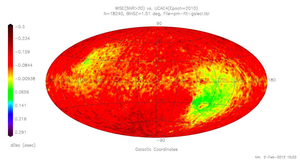 |
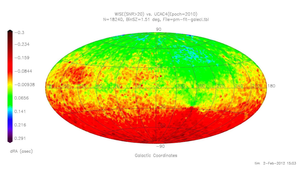 |
| Figure 12 - The declination component of the difference between WISE and UCAC4-epoch2010 positions for WISE sources with SNR>20. Color coding is in units of arcseconds. | Figure 13 - As in Figure 12, but for the right ascension component. |
As a direct test of the slight reference frame distortion of WISE relative to the ICRS Figures 14 and 15 show the position residuals for 2000 quasars appearing in the WISE Catalog. This sample is sparse relative to the entire sky, so the results are binned over large areas. Nevertheless, the patterns expected in declination (Figure 14) right ascension (Figure 15) mimic in morphology and amplitude those discussed in Figures 12 and 13.
The WISE-reported positions of sources brighter than W1<12.5 mag exhibit one-sigma residuals with respect to the 2MASS Point Source Catalog reference frame of <0.2 arcseconds in Right Ascension and Declination with bias relative to the 2MASS astrometric reference frame of typically less then 30 milliarcseconds over the entire sky. The faint sources are similarly unbiased but have larger astrometric residuals due to noise. At the SNR=20 level typical positional uncertainty is of order 0.4" per axis.
Due to the decade of proper motion between the WISE and 2MASS epochs the WISE coordinate reference frame is slightly distorted relative to the International Celestial Reference Frame. In the worst directions this bias can be as large as ~0.15".
As Figures 16 and 17 illustrate (as well as figures 3 and 4) there is no evidence for any significant population of astrometric outliers over the full sky.


